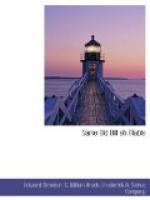pund saltes of thon sindon salto tehero pund deawes of thon pondus salis, inde sunt salsae lacrimae; pondus roris, unde
aworden is swat pund blostmes of thon is fagung egena factus est sudor; pondus floris, inde est uarietas oculorum;
pund wolcnes of thon is unstydfullnisse vel unstatholf{ae}stnisse
pondus nubis, inde est instabilitas
thohta
mentium;
pund windes of thon is oroth cald pund gefe of thon is pondus uenti, inde est anhela frigida: pondus gratiae, id est
thoht monnes sensus hominis.
We thus learn that Adam’s flesh was made of a pound of loam; his red and hot blood, of fire; his salt tears, of salt; his sweat, of dew; the colour of his eyes, of flowers; the instability of his thoughts, of cloud; his cold breath, of wind; and his intelligence, of grace.
The Northumbrian glosses on the four Gospels are contained in two MSS., both of remarkable interest and value. The former of these, sometimes known as the Lindisfarne MS., and sometimes as the Durham Book, is now MS. Cotton, Nero D. 4 in the British Museum, and is one of the chief treasures in our national collection. It contains a beautifully executed Latin text of the four Gospels, written in the isle of Lindisfarne, by Eadfrith (bishop of Lindisfarne in 698-721), probably before 700. The interlinear Northumbrian gloss is two and a half centuries later, and was made by Aldred, a priest, about 950, at a time when the MS. was kept at Chester-le-Street, near Durham, whither it had been removed for greater safety. Somewhat later it was again removed to Durham, where it remained for several centuries.
The second MS. is called the Rushworth MS., as it was presented to the Bodleian Library (Oxford) by John Rushworth, who was deputy-clerk to the House of Commons during the Long Parliament. The Latin text was written, probably in the eighth century, by a scribe named Macregol. The gloss, written in the latter half of the tenth century, is in two hands, those of Farman and Owun, whose names are given. Farman was a priest of Harewood, on the river Wharfe, in the West Riding of Yorkshire. He glossed the whole of St Matthew’s Gospel, and a very small portion of St Mark. It is worthy of especial notice, that his gloss, throughout St Matthew, is not in the Northumbrian dialect, but in a form of Mercian. But it is clear that when he had completed this first Gospel, he borrowed the Lindisfarne MS. as a guide to help him, and kept it before him when he began to gloss St Mark. He at once began to copy the glosses in the older MS., with slight occasional variations in the grammar; but he soon tired of his task, and turned it over to Owun, who continued it to the end. The result is that the Northumbrian glosses in this MS., throughout the three last Gospels, are of no great value, as they tell us little more than can be better learnt from the Durham book; on the other hand, Farman’s Mercian gloss to St Matthew is of high value, but need not be considered at present. Hence it is best in this case to rely, for our knowledge of Old Northumbrian, on the Durham book alone.




